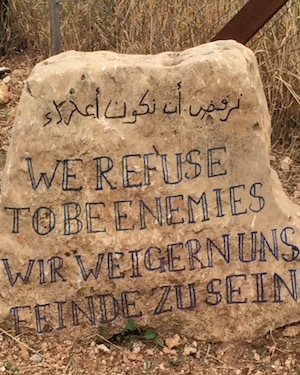
The upcoming General Assembly (2016) will act on “Risking Peace in a Violent World and the Five Affirmations,” as recommended by the Advisory Committee on Social Witness Policy. The Report and the Five Affirmations are a substantial move toward strengthening the PC(USA) witness for peace. The report has been six years in development, including an invitation to presbyteries to engage in a Peace Discernment process with responses sent to the Committee and approvals of study and discussion material by the General Assembly in 2012 and 2014.
In this article, I will maintain that our church and culture are desperately in need of an effective peace witness. This report is itself strong, and the question is, will it strengthen our peace witness, both in our denominational program and in our congregations and presbyteries? As a former division director in Louisville, I can imagine the obstacles today, but I also want to look back a bit at a very well-designed program that should still have capacity to serve the Gospel of Peace. Have the disastrous and constant wars since 9/11 made us afraid to risk a peace witness today? That is the challenge in this report. I believe there still are a good number of congregations who want a vibrant program and are still willing to pay for it.
___________________________________________
“Risking Peace” comes at a time when the U.S. has been involved in wars for fifteen years in Iraq, Afghanistan, and other places. A faithful response will take more than business as usual.
___________________________________________
The Five Affirmations, the heart of the report, will set directions for the peacemaking witness of the church today, much as “Peacemaking: The Believers’ Calling” did 35 years ago:
- Affirmation #1: We affirm that peacemaking is essential to our faith in God’s reconciling work in Jesus Christ, whose love and justice challenge evil and hatred, and who calls the church to present alternatives to violence, fear, and misused power.
- Affirmation #2: We confess our complicity in the world’s violence and our failures to stand with those who suffer, even as we pray for the Spirit’s courage to unmask idolatries, speak truth about war and oppression, and respond with ministries of justice, healing, and reconciliation.
- Affirmation #3: We follow Jesus Christ, Prince of Peace and Reconciler, and reclaim the power of nonviolent love evident in his life and teaching, his healings and reversals of evil, his cross and resurrection.
- Affirmation #4: Learning from nonviolent struggles and counting the costs of war, we draw upon the traditions of Just War, Christian pacifism, and Just Peacemaking to cultivate moral imagination and discern God’s redemptive work in history.
- Affirmation #5: We commit ourselves to practice the things that make for peace in our daily lives, families, and communities, to risk calling our nation back from the practices of empire to the highest ideals of our heritage, and to take part in social movements for a domination-free order.
“Risking Peace and the Five Affirmations,” as the report analyzes, comes at a time when the U.S. has been involved in wars for fifteen years in Iraq, Afghanistan, and other places. The current world scene is full of violence with no end in sight. This context should shape the church’s response to “Risking Peace in a Violent World.” A faithful response will take more than business as usual. Michael Jinkins, President of Louisville Presbyterian Theological Seminary, has been reflecting on the current global context and the role of the church. He raises disturbing questions about the church, our current context, and Nazi Germany:
When we ask the question “How could a nation like Germany allow itself to be seduced by Nazism?”, we have to reckon with the fact, as uncomfortable as it may be, that Hitler used the mechanisms of a democratic process to rise to power. As Ian Kershaw observes in the second volume of his magisterial study of Hitler: “By the time he was levered into power, the ‘redemptive’ politics which Hitler preached – the overturning of the defeat and revolution of 1918 at their heart – had won the support of over 13 million Germans, among them an activist base of well over a million members of the various branches of the Nazi Movement.” [1]
Tragically, the overwhelming majority of Protestants in Germany tried to balance themselves precariously on the fence, hoping neither to be identified with Hitler’s henchmen nor to attract their ire. Like the Laodiceans of John’s Revelation, they were neither hot nor cold, but lukewarm as they staggered toward the apocalypse (Revelation 3:13-17) …
Existing “for others” is what it means to be like Jesus of Nazareth. Not to exist “for others” is to deny Christ. Thus, if some “Führer,” some “strong leader” or some political idol sculpted and crafted by human hands comes along and tells us that our prosperity, security, or national future can be secured by demeaning, destroying, torturing, and vilifying others – strangers, aliens, foreigners, immigrants, outsiders – the Christian’s choice isn’t all that hard to figure out. Michael Jinkins, “How could This Happen? Bonhoeffer’s Germany,” 4/28/2016 and 5/12/2016, HuffPost Religion blog.
Jinkins is on target that the strong witness of the church is urgently needed in such a time as this. Add to the violent world context the upcoming national election which will decide presidential leadership in the U.S. for at least four years, and the peacemaking efforts of the church becomes ever more crucial.

This global and national context and the proposed report, “Risking Peace in a Violent World and Five Affirmations” challenge the church to respond. We will need strong leadership and resourcing to assist the church. Can the Presbyterian Peacemaking Program step up to the plate in this context?
The Peacemaking Program, now thirty-five years old, played a significant role in the denomination after the General Assembly adopted “Peacemaking: the Believers’ Calling” in 1980. Recall that sessions were urged to support “Peacemaking, the Believers’ Calling” by endorsing “The Commitment to Peacemaking” and notifying the Peacemaking Program. This process of session involvement encouraged congregations to become active in peacemaking ministry. A tally was kept and publicized across the church as a way of challenging other congregations to act. The total number of congregations that endorsed the Commitment to Peacemaking was approximately 50% at last count. (The tally seems no longer kept or used as a program incentive.)
The Presbyterian Peacemaking Program was funded by a new special offering, the Peacemaking Offering, which had a new creative approach to fund raising. 25% of the offering was designated to remain in the congregation and 25% to remain in the presbytery, thus providing resources to undertake new initiatives; 50% was designated for denominational mission. A majority of congregations have received the Peacemaking Offering at some time. The offering became another way of challenging and resourcing the church to engage in peacemaking.
___________________________________________
The Presbyterian Peacemaking Program, which began as a joint program of the UPUSA and the PCUS in the time before reunion, was significant because neither denomination had had a strong peacemaking witness before.
___________________________________________
Denominational conferences were held at Montreat and Ghost Ranch where folks could learn new skills as well as from each other and be challenged to new initiatives. Travel seminars to the Soviet Union and other places illuminated the global context of the Cold War. The program made a concerted effort to stay in touch with presbytery Peacemaking Committees and assist them in resourcing congregations.

Photo: Presbyterian Peacemaking Program
Many congregations engaged in a ministry of peacemaking that had not done so before. This new denominational effort, which began as a joint program of the UPUSA and the PCUS in the time before reunion, was significant because neither denomination had had a strong peacemaking witness before.
Over the years, however, the Presbyterian Peacemaking Program has lost some of its momentum. There is no annual conference. The Peacemaking Offering has been combined with something called Global Witness to become the Peace and Global Witness Offering. Until recently, there were two staff positions in PPP: the Coordinator who serves as the staff leader and the Associate for Constituency Support. Do these continue? What is the relation of the Program to the Ministry at the United Nations? News of Peacemaking Program can be found from time to time but not regularly in the Compassion, Peace, and Justice unit’s newsletter. Does PPP know which presbyteries currently have Peacemaking Committees?
___________________________________________
The search for peace “requires that the nations pursue fresh and responsible relations across every line of conflict, even at risk to national security” (C67).
___________________________________________
One longtime initiative that is maintained is the International Peacemaker program. Each year a number of people from various regions of the world come to the U.S. Each is assigned to visit several presbyteries for several days to share their experiences in their local context. Presbytery committees arrange various ways for them to share their peacemaking witness with congregations. This year, travel seminars have also been sponsored to the Middle East and Russia. How do these components speak to the rest of the congregations in the church?

Photo: Presbyterian Peacemaking Program
However, the new report “Risking Peace in a Violent World and the Five Affirmations” breaks new ground and will require new initiatives to enable the church to live out these Affirmations. What those new initiatives should be will require some creative planning. This planning needs to begin as soon as possible. Will staff be up to this effort? (The Peacemaking Advisory Committee was disbanded long ago).
The Presbyterian Mission Agency, the Compassion, Peace, and Justice Unit, and the Peacemaking Program need to work out a way to begin the creative program planning that is urgently needed. We, as a church, cannot afford to falter with both new opportunities and the current challenges of the national and global context. The search for peace “requires that the nations pursue fresh and responsible relations across every line of conflict, even at risk to national security” (The Confession of 1967). As Michael Jinkins reminds us, we cannot try to balance on the fence. We must be willing to “exist for others”, lest we deny Christ in our own time.
________________________________________________
[1] Ian Kershaw, Hitler: 1936-45 Nemesis (New York: W.W. Norton, 2000), p. xiii.
*****
AUTHOR BIO: Belle Miller McMaster retired after serving as Director of Advanced Studies at Candler School of Theology, Emory University. Prior to that she served as Director of Social Justice and Peacemaking Ministry Unit, PC(USA) and Director of Corporate and Social Mission, PCUS. She is a ruling elder and member of Druid Hills Presbyterian Church, Atlanta, GA.
Read ACSWP Report 12-06: “Risking Peace in a Violent World: Five New Peacemaking Affirmations.”






Unbound Social